
Dimdima
Online Children's Magazine from India

Dimdima
Online Children's Magazine from India
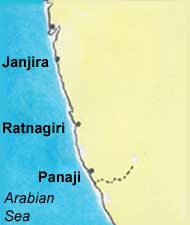
South of Janjira, at the mouth of the river Savitri, lies Harihareshwar, also called Devgarh, 'The House of God'. The temples on its beach have made it a pilgrim centre. One of the temples, called the Kal-Bhairav temple has lingams which are believed to have formed on their own. Once every year, the statue of Kal-Bhairav is taken in a palanquin to the hills, named after Brahma, Vishnu, Mahesh and Parvati.
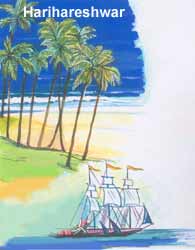 To the south of Harihareshwar lies Bankot. In the 18th century, Bankot's fort became the stronghold of the great Maratha admiral Kanhoji Angre.
To the south of Harihareshwar lies Bankot. In the 18th century, Bankot's fort became the stronghold of the great Maratha admiral Kanhoji Angre.
In 1756 the Marathas ceded it to the British in exchange for Gheria (Vijayadurg) and it became the first 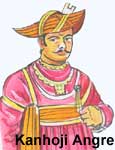 British possession on the mainland of Western India.
British possession on the mainland of Western India.
The well-known Maratha statesman, Nana Phadnavis, was born a few miles south of Bankot at Velas.
A port that flourished for centuries together in ancient times is Paripatana or Palaepatme. It lies south of Bankot 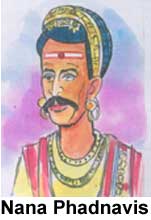 and used to be the principal port of South Konkan from the 14th to the 16th centuries, when it carried on extensive trade with ports in the Mediterranean and in the Persian Gulf. The town was later named Dabhol after Dabhiya, a god who is believed to frequent forests.
and used to be the principal port of South Konkan from the 14th to the 16th centuries, when it carried on extensive trade with ports in the Mediterranean and in the Persian Gulf. The town was later named Dabhol after Dabhiya, a god who is believed to frequent forests.
Dabhol's landmarks are a beautiful old mosque, which is the only existing example of pure Saracenic architecture in southern Konkan, and the underground Chandrikabu temple, that was built between AD 550 - 578.
Further south on the picturesque Konkan coast is the seaside town of Ganapatipule. The entire town is covered with cashew, coconut, mango and casuarina trees. Ganapatipule, as its name suggests, has a famous Ganapati temple. The idol of Ganapati here, believed to have formed on its own, was discovered 400 years ago at the foot of a hillock. Thousands of pilgrims visit this temple, especially on Angaraki Chaturthi festival, when they fast the whole day, and break it at moon-rise, after offering the deity 'modak', a sweet made from rice flour, coconut and jaggery.
The sour, juicy fruit, kokam, grows in abundance here and all along the Konkan. The 'kokam sherbet', a drink made from the purplish fruit, is the main thirst-quencher of the Konkan. Once the juice has been extracted for making the sherbet, salt is added to the squeezed-out fruit, which is then dried in the sun for around ten days. The dried kokam is later used in the same way as tamarind to give a sour taste to curries.
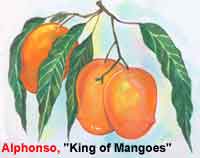
Mangoes grow allover India, but Ratnagiri's Alphonso or 'Apuse' (as the locals call their favourite fruit), is regarded as the  king of mangoes. Ratnagiri is a minor port. The most important monument here is the Lokmanya Tilak Memorial, the house where Bal Gangadhar Tilak, one of the country's foremost freedom fighters, was born on July 23, 1856.
king of mangoes. Ratnagiri is a minor port. The most important monument here is the Lokmanya Tilak Memorial, the house where Bal Gangadhar Tilak, one of the country's foremost freedom fighters, was born on July 23, 1856.
Vijayadurg, a strong sea fortress in the Konkan, lies a little to the south of Ratnagiri. Along with Sindhudurg, it served as the naval base of the Marathas. It was called Gheria till Shivaji changed its name to Vijayadurg. Except for its western wall, which is exposed to the fury of the sea, the fort is well-preserved.

Several kilometres south lies Malwan, which was once a famous trading port. 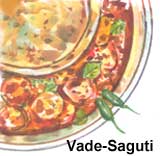 Today it is known for its salt pans and its cuisine. A Malwan meal is incomplete without 'Sol kadhi' (a dish made of kokam) and fish curry, made with plenty of coconut. The most popular Malwan meal, however, is 'Vade-Saguti', rice flour puris and a delicious meat gravy.
Today it is known for its salt pans and its cuisine. A Malwan meal is incomplete without 'Sol kadhi' (a dish made of kokam) and fish curry, made with plenty of coconut. The most popular Malwan meal, however, is 'Vade-Saguti', rice flour puris and a delicious meat gravy.
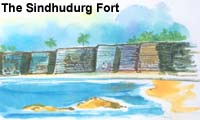 Just off the coast barely a kilometre away, lies Sindhudurg, a fort that Shivaji is said to have built with his own hands. Limestone slabs that bear Shivaji's hand and foot prints have been enshrined in small domes close to a temple which has an idol of the Maratha warrior. This is the only temple in the country dedicated
Just off the coast barely a kilometre away, lies Sindhudurg, a fort that Shivaji is said to have built with his own hands. Limestone slabs that bear Shivaji's hand and foot prints have been enshrined in small domes close to a temple which has an idol of the Maratha warrior. This is the only temple in the country dedicated 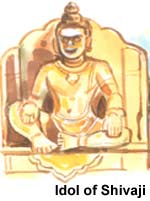 to Shivaji. His idol is made of black stone. On special occasions the silver mask that covers his head, is replaced with one of gold.
to Shivaji. His idol is made of black stone. On special occasions the silver mask that covers his head, is replaced with one of gold.
The coastal town of Vengurla lies almost at the end of the Maharashtra coast, quite close to Goa.
It was a trade settlement in the past, exporting coconuts, coir, molasses and cashewnuts. The town was attacked and plundered repeatedly between 1664 and 1812 by pirates who infested the coast. It was burnt to the ground twice by the Marathas and the Mughals.
Vengurla is a hilly town with long stretches of sand. Cashew, coconut, jackfruit and mango groves can be seen here. The Shri Devi Sateri temple and the Rameshwar Mandir are the two famous temples of Vengurla.
Last updated on :1/12/2005
Dimdima is the Sanskrit word for ‘drumbeat’. In olden days, victory in battle was heralded by the beat of drums or any important news to be conveyed to the people used to be accompanied with drumbeats.
Bharatiya Vidya Bhavan
K. M Munshi Marg,
Chowpatty, Mumbai - 400 007
email : editor@dimdima.com
Bharatiya Vidya Bhavan
505, Sane Guruji Marg,
Tardeo, Mumbai - 400 034
email : promo@dimdima.com
Dimdima.com, the Children's Website of Bharatiya Vidya Bhavan launched in 2000 and came out with a Printed version of Dimdima Magazine in 2004. At present the Printed Version have more than 35,000 subscribers from India and Abroad.